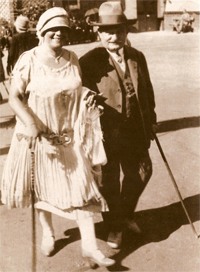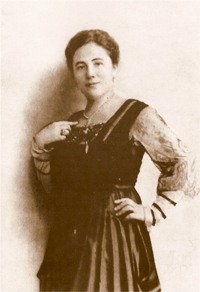Leoš Janáček visited the local region and Luhačovice at the invitation of his uncle, Jan Janáček, the pastor of Vnorovy, at the end of the 19th century. In 1903, he started visiting Luhačovice quite often. The historical records state that he visited Luhačovice for twenty five times and spent 60 days there.

During his stays in Luhačovice, he lived at the Vlastimila villa, Růžová villa (now Alpská růže), Jan's house (now Jurkovič's house), the Director's house (demolished in 1946), Spa Hotel, Jestřabí and Augustinian house.
The Luhačovice Spa became the place of his favourite stays where he underwent treatment not only of his illnesses, but also of his "hurting soul" at the times when he lost his beloved daughter Olga and son Vladimír and recovered from his unhappy marriage. He first visited Luhačovice in 1903 at the invitation of MUDr. František Veselý, the Director of the First Joint-stock Luhačovice Spa Company, whom Master Janáček had known from Brno.
Leoš Janáček recorded the melodies of intonation of the local language through which he recorded human speech and later also the surrounding sounds in music examples. The spa offered a rich source of inspiration and miscellaneous register of languages and dialects.
Leoš Janáček filled his first notebook with dozens of melodies during his first stay in Luhačovice in 1903. They represented his ordinary everyday contact with the local inhabitants and spa guests, atmosphere and sound environment during drinking of the mineral water, procedures, at restaurants, at the promenade or during the walks in nature. He processed his sketches right after summer in the autumn; he harmonized some and published them in the sketch called My Luhačovice.

Luhačovice was also the place of "fateful" meetings in the composer's life. During his August stay in 1903, he met Kamila Urválková whose life story inspired him to write the opera Fate, whose one part takes place at the spa colonnade. In 1908, he met Marie Calma-Veselá, the wife of the founder of the Joint-stock Luhačovice Spa Company who supported the showing of the opera Jenufa at the National Theatre in Prague.
The third fateful meeting happened in 1917 when Janáček met Kamila Stösslová. She became a great inspiration to Janáček for the rest of his life, the source of his peak composing period, the friend and love of his life.
In 1916, Gabriela Horvátová, the soprano at the National Theatre in Prague, also visited the spa with Leoš Janáček. Their friendship started when the National Theatre in Prague performed Jenufa, where she played the character of the Verger.

In 1926, Master Janáček composed his famous Glagolitic Mass during his three-week stay at the Augustinian house in Luhačovice.
Leoš Janáček came to Luhačovice on 1 July 1928 for the last time. He celebrated his 74th birthday on the third day after his arrival. After the three-week stay, he left for Brno on 21st July where he waited for Kamila Stösslová, whom he invited to Hukvaldy, where they went together with her son on 30 th July. He caught a cold during a walk in a storm on 6th August and came down with it after two days. On 10th August he was taken to the Ostrava hospital with pneumonia where he died on 12th August 1928.